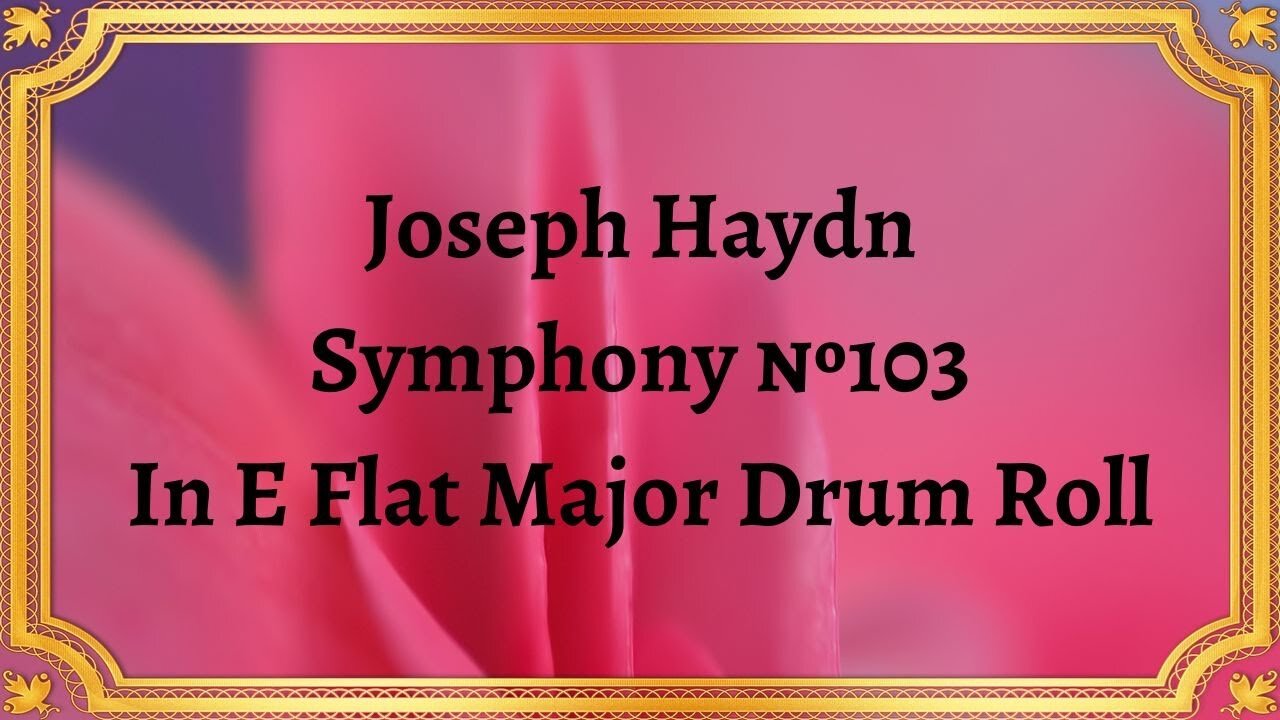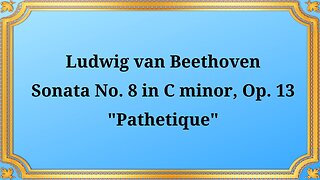Premium Only Content

Joseph Haydn Symphony №103 In E Flat Major Drum Roll
#JosephHaydn #SymphonyNo103 #EFlatMajor #DrumRoll #ClassicalMusic #MusicalComposition #HaydnSymphony #OrchestralMusic #MusicAppreciation #MusicHistory #Composer #Musician #ClassicalPeriod #MusicEnsemble #InstrumentalMusic #Symphony #ConcertMusic #MusicPerformance #MusicEducation #MusicScholarship
Publication date 1951
Wiener Symphoniker; Hermann Scherchen
Joseph Haydn, a prominent composer of the Classical era, created a vast body of work that greatly influenced the development of symphonic music. Among his numerous symphonies, Symphony No. 103 in E Flat Major, commonly known as the "Drum Roll," stands out as a remarkable composition.
Symphony No. 103 was composed by Joseph Haydn in 1795 during his prolific years in London. Haydn spent a significant portion of his career in London, where he enjoyed great success and popularity. The "Drum Roll" Symphony was one of the twelve symphonies he composed for his London concerts, showcasing his mastery and innovation in symphonic composition.
Symphony No. 103 follows the traditional four-movement structure of a Classical symphony:
a. Movement I - Adagio: The symphony opens with a majestic slow introduction, setting a dramatic and anticipatory mood.
b. Movement II - Andante più tosto Allegretto: The second movement transitions to a lyrical and serene melody, providing a contrasting atmosphere.
c. Movement III - Menuetto: A graceful and elegant minuet and trio form the third movement, displaying Haydn's signature charm and wit.
d. Movement IV - Finale: The symphony concludes with a lively and energetic finale, characterized by its dramatic drum roll, after which the symphony is named.
Haydn's Symphony No. 103 is scored for a standard Classical orchestra, including strings, woodwinds, brass, and percussion. The inclusion of the drum roll in the final movement adds a unique and memorable element to the composition.
Haydn's melodic lines exhibit a playful and inventive character, showcasing his ability to create catchy and memorable tunes. The harmonic progressions are well-crafted, balancing tension and resolution to create a sense of musical satisfaction.
The inclusion of a prominent drum roll in the final movement of Symphony No. 103 was a groundbreaking choice by Haydn. This bold addition not only added excitement and anticipation to the composition but also influenced future composers to explore the potential of percussion instruments in symphonic music.
Haydn's "Drum Roll" Symphony set a precedent for later symphonies, inspiring composers to experiment with form, orchestration, and dramatic effects. Its impact can be heard in the works of Beethoven, Mozart, and other composers of the Romantic era.
Symphony No. 103's engaging melodies, dynamic contrasts, and dramatic drum roll captivate audiences of all generations. Its popularity continues to endure, making it a staple of orchestral repertoire.
Conclusion:
Joseph Haydn's Symphony No. 103 in E Flat Major, known as the "Drum Roll," represents a significant contribution to the symphonic repertoire. Its historical context, unique musical elements, and lasting impact make it an essential work in the Classical period. The inclusion of the drum roll in the final movement showcased Haydn's innovative spirit and influenced future composers. With its engaging melodies and dramatic effects, Symphony No. 103 continues to captivate audiences, solidifying Haydn's legacy as a master symphonist.
You have the opportunity to support the channel https://destream.net/live/RadSiarAl/donate
-
 18:26
18:26
Classical music_Music Inspiration
1 month agoLudwig van Beethoven Piano Sonata No. 8 in C minor, Op. 13 "Pathétique"
591 -
 1:25:18
1:25:18
Jeff Ahern
2 hours ago $5.60 earnedThe Sunday Show with Jeff Ahern
14.1K7 -
 31:37
31:37
The Rad Factory
1 day ago $9.60 earnedTesting $300 Amazon Supercharger: Will It Blow??
27.7K12 -
 LIVE
LIVE
Spartan
3 hours agoSpartan - Pro Halo Player for OMiT | Scrims vs C9 then ranked
357 watching -
 22:02
22:02
Mrgunsngear
19 hours ago $9.42 earnedHeckler & Koch Full Size VP9A1 F Review: The Best Striker Fired Duty Handgun?
24K18 -
 LIVE
LIVE
Gore TV
5 hours ago🔥💥 MY GUN BROKE MID-FIGHT?! 🤯💣 | Division 2 Chaos with a Toy Rifle 😂🔫
206 watching -
 17:14
17:14
JapaNomad - Video Tours
3 days ago $2.90 earnedNissan GT-R R35 2AM Tokyo Expressway Run | Pure Car ASMR | No Music | No Voice | 4K HDR
24.8K5 -
 27:35
27:35
NordicVentures
7 days ago $2.22 earned3 Days Solo on a Island: How to Build a Simple Beach Shelter!
20.3K7 -
![LIVE Replay - Back from the Beginning! [Elden Ring]](https://1a-1791.com/video/fww1/3e/s8/1/W/K/Z/3/WKZ3y.0kob.1-small-Back-from-the-Beginning-Eld.jpg) 2:06:54
2:06:54
JTtheSG
3 hours agoLIVE Replay - Back from the Beginning! [Elden Ring]
13.5K -
 LIVE
LIVE
Barneyjack
3 hours agoWarframe LR$/MR34 Game and Giveaways!! Get in here :) :)
59 watching